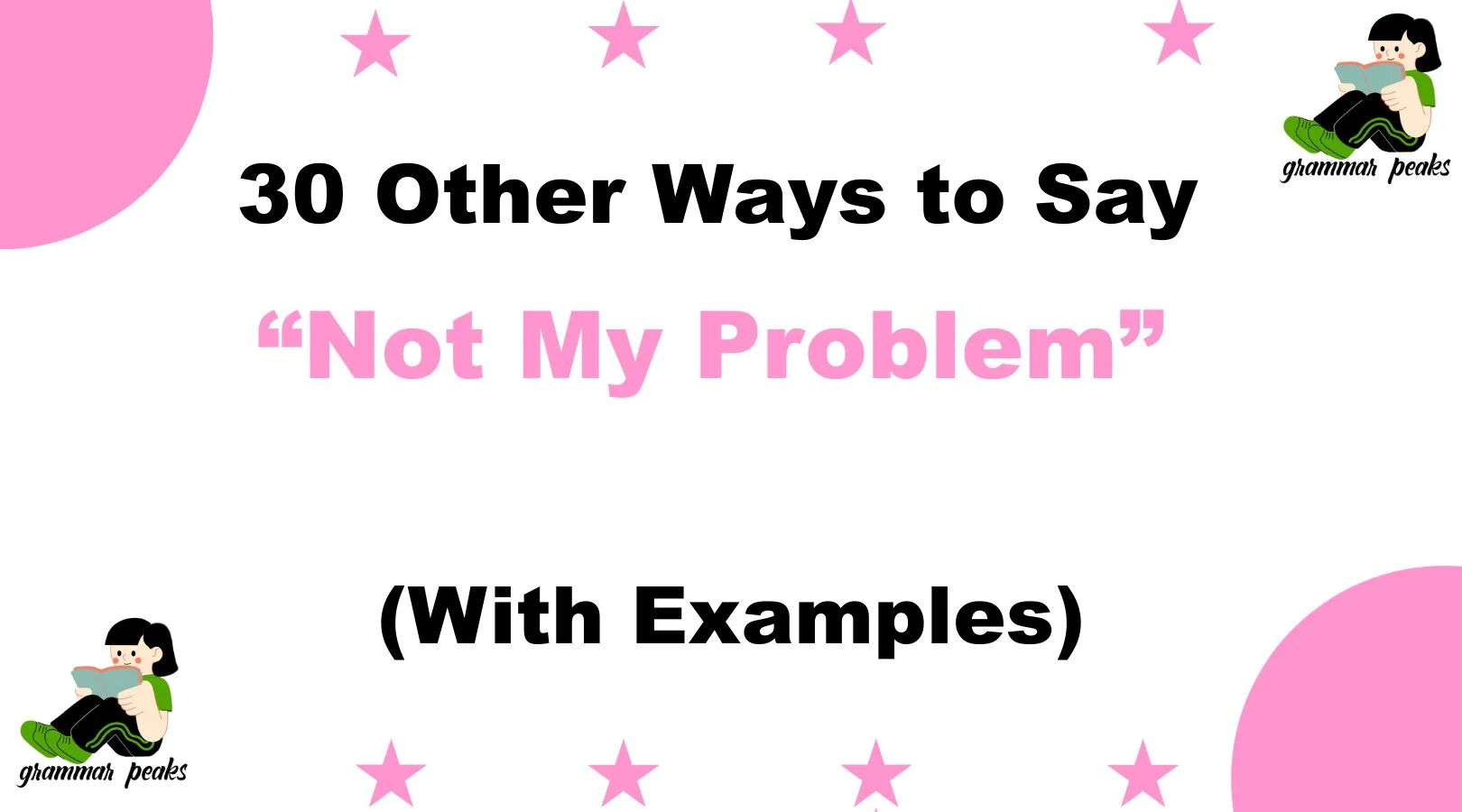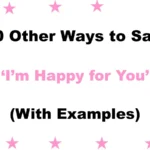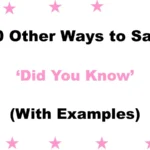Sometimes, you need to set a boundary, avoid being pulled into drama, or clarify that a situation isn’t your responsibility—without sounding harsh, dismissive, or unhelpful. Saying “not my problem” may feel honest, but it can often come across as cold, unprofessional, or even rude. Thankfully, there are better ways to express the same message while keeping your tone respectful, diplomatic, or tactful.
Here are 30 thoughtful alternatives to “Not My Problem,” each with examples, explanations, and guidance on the best and worst situations to use them in.
What Does “Not My Problem” Mean?
“Not my problem” is a blunt way to say that a particular issue, concern, or responsibility does not fall under your duty or control. While it communicates emotional or logistical distance, it often lacks empathy or cooperation and can create tension in professional or personal relationships.
When to Use “Not My Problem”
You might need to convey this idea when:
- A request is beyond your role or scope
- Someone expects you to fix something you didn’t cause
- You need to enforce personal or professional boundaries
- You want to redirect responsibility to the correct party
Is It Professional or Polite to Say “Not My Problem”?
In most cases, no. The phrase is generally viewed as dismissive or unhelpful, especially in work environments. Even if you’re right to decline responsibility, there’s almost always a more professional and considerate way to say it. Replacing it with empathetic, clear language can protect your relationships and reputation while still maintaining your boundaries.
Pros and Cons
Pros:
- Direct and unambiguous
- Protects your time and energy
- Clearly sets limits on accountability
Cons:
- Can seem rude or uncaring
- Damages trust and teamwork
- May escalate conflict or hurt feelings
Synonyms For “Not My Problem”
- That’s outside my responsibilities
- I’m not the right person to handle this
- You’ll need to speak with [person/department] about that
- I can’t take that on right now
- That’s not within my control
- I don’t have the authority to decide that
- I’d love to help, but this falls outside my role
- That’s not something I can assist with
- I suggest bringing this up with someone who handles that area
- I don’t want to speak on behalf of someone else
- This isn’t something I’m involved in
- I’m not in a position to help with that
- I recommend checking with someone who handles that
- I trust you’ll be able to take care of this
- I don’t want to overstep
- That’s not part of my current priorities
- I’m focusing on other tasks at the moment
- It’s best if this is handled by the appropriate team
- This isn’t within my decision-making power
- Unfortunately, I can’t take responsibility for this
- I think someone else is better suited to help
- Let me connect you with the right person
- I’m not equipped to help with that
- This isn’t something I’m able to take on
- That sounds tough—I hope you find the support you need
- That’s not something I can commit to
- This falls outside my scope
- My focus is elsewhere right now
- This isn’t something I can prioritize at the moment
- I’ve done my part—this now belongs to someone else
1. That’s outside my responsibilities
Definition: A polite way to clarify that the issue isn’t your task.
Detailed Explanation: This is ideal in professional settings where roles are clearly defined.
Scenario Example: “I understand the concern, but that’s outside my responsibilities. You might want to check with Facilities.”
Best Use: Work-related boundaries.
Worst Use: When you actually could help but don’t want to.
Tone: Professional, boundary-setting.
2. I’m not the right person to handle this
Definition: Redirects the issue to someone more qualified or responsible.
Detailed Explanation: This avoids blame and keeps things moving toward a solution.
Scenario Example: “I’m not the right person to handle this, but let me connect you with someone who can.”
Best Use: Customer service, workplace hierarchy.
Worst Use: As an excuse to avoid accountability.
Tone: Helpful, redirecting.
3. You’ll need to speak with [person/department] about that
Definition: Points someone to the proper source for help.
Detailed Explanation: It’s a diplomatic way to transfer responsibility without sounding uninterested.
Scenario Example: “You’ll need to speak with HR about that—it’s their policy.”
Best Use: Referring policies or departmental duties.
Worst Use: If it sounds like you’re brushing them off.
Tone: Informative, courteous.
4. I can’t take that on right now
Definition: Sets a capacity limit without being dismissive.
Detailed Explanation: A softer way to say “I don’t have bandwidth” without sounding like you don’t care.
Scenario Example: “I understand it’s urgent, but I can’t take that on right now.”
Best Use: When you’re at full workload.
Worst Use: If the task is actually your responsibility.
Tone: Respectful, firm.
5. That’s not within my control
Definition: States that you don’t have authority over the issue.
Detailed Explanation: This is great when someone expects you to act on something you literally can’t change.
Scenario Example: “Unfortunately, that’s not within my control. I recommend reaching out to the vendor directly.”
Best Use: Tech support, customer service, team boundaries.
Worst Use: When it is within your control.
Tone: Honest, neutral.
6. I don’t have the authority to decide that
Definition: Clear, respectful acknowledgment of a limitation.
Detailed Explanation: Ideal when others assume you can fix or approve something you legally or professionally can’t.
Scenario Example: “I’d love to help, but I don’t have the authority to decide that.”
Best Use: Administrative or hierarchical environments.
Worst Use: If it’s just being used to avoid responsibility.
Tone: Respectful, factual.
7. I’d love to help, but this falls outside my role
Definition: A warm, human-centered way of setting a boundary.
Detailed Explanation: Great for maintaining goodwill even while declining.
Scenario Example: “I’d love to help, but this falls outside my role. Have you asked the operations team?”
Best Use: Team collaboration, cross-department issues.
Worst Use: If the tone feels performative.
Tone: Friendly, professional.
8. That’s not something I can assist with
Definition: Formal and neutral version of “not my problem.”
Detailed Explanation: Best when you want to keep things short and businesslike.
Scenario Example: “I’m sorry, but that’s not something I can assist with. I recommend reaching out to your manager.”
Best Use: Professional, formal settings.
Worst Use: Casual conversations where this tone might feel stiff.
Tone: Neutral, restrained.
9. I suggest bringing this up with someone who handles that area
Definition: Encourages the other person to find the right resource.
Detailed Explanation: You’re offering guidance without taking on the issue yourself.
Scenario Example: “I suggest bringing this up with someone who handles that area—try the compliance team.”
Best Use: Cross-functional questions.
Worst Use: When it’s clearly within your lane.
Tone: Helpful, detached.
10. I don’t want to speak on behalf of someone else
Definition: Sets a respectful boundary around responsibility and representation.
Detailed Explanation: Especially useful when asked to comment or act on another person’s role.
Scenario Example: “I don’t want to speak on behalf of someone else—you should probably ask her directly.”
Best Use: Avoiding assumptions or misrepresentation.
Worst Use: When you’re avoiding ownership of a joint task.
Tone: Respectful, honest.
11. This isn’t something I’m involved in
Definition: Politely clarifies your detachment from the issue.
Detailed Explanation: It sets a boundary without implying disregard.
Scenario Example: “I understand why it’s frustrating, but this isn’t something I’m involved in.”
Best Use: Group projects, unclear accountability.
Worst Use: When you’ve previously committed to help.
Tone: Calm, respectful.
12. I’m not in a position to help with that
Definition: Indicates a lack of power or resources.
Detailed Explanation: This is great when you’re willing but unable to help.
Scenario Example: “I hear what you’re saying, but I’m not in a position to help with that right now.”
Best Use: Power dynamics, limited roles.
Worst Use: When used as a brush-off.
Tone: Honest, regretful.
13. I recommend checking with someone who handles that
Definition: Offers redirection while staying solution-oriented.
Detailed Explanation: Keeps the tone constructive without taking ownership.
Scenario Example: “This sounds like a finance question. I recommend checking with someone who handles that.”
Best Use: When you genuinely want to be helpful.
Worst Use: If it sounds like a deflection.
Tone: Helpful, cooperative.
14. I trust you’ll be able to take care of this
Definition: Puts ownership back on the person without sounding cold.
Detailed Explanation: It can feel empowering if said sincerely.
Scenario Example: “It sounds like something you’ve handled before—I trust you’ll be able to take care of this.”
Best Use: Delegation, coaching.
Worst Use: When the person clearly needs support.
Tone: Encouraging, light.
15. I don’t want to overstep
Definition: Signals that the issue falls into someone else’s jurisdiction.
Detailed Explanation: Great for sensitive topics or team boundaries.
Scenario Example: “I think that’s best left with your manager—I don’t want to overstep.”
Best Use: Hierarchical situations.
Worst Use: When avoiding necessary leadership.
Tone: Cautious, respectful.
16. That’s not part of my current priorities
Definition: Reframes “not my problem” in terms of workload.
Detailed Explanation: It emphasizes focus rather than denial.
Scenario Example: “I’d like to help, but that’s not part of my current priorities.”
Best Use: Time and workload management.
Worst Use: When the issue is urgent or critical.
Tone: Professional, assertive.
17. I’m focusing on other tasks at the moment
Definition: States what you are doing, instead of what you won’t do.
Detailed Explanation: It gives context to your refusal.
Scenario Example: “I’m focusing on other tasks at the moment. Can you check with someone else?”
Best Use: Busy periods, time blocking.
Worst Use: If you appear dismissive.
Tone: Busy but respectful.
18. It’s best if this is handled by the appropriate team
Definition: Reaffirms roles and process without sounding cold.
Detailed Explanation: Keeps things organized and professional.
Scenario Example: “It’s best if this is handled by the appropriate team—they have the tools and authority.”
Best Use: Multi-team organizations.
Worst Use: When you’re gatekeeping unnecessarily.
Tone: Structured, composed.
19. This isn’t within my decision-making power
Definition: Clarifies boundaries around decision authority.
Detailed Explanation: Useful when you’re asked to act beyond your role.
Scenario Example: “This isn’t within my decision-making power—you’ll want to speak with a director.”
Best Use: Chain-of-command clarification.
Worst Use: When you actually do have influence.
Tone: Straightforward, firm.
20. Unfortunately, I can’t take responsibility for this
Definition: Firmly states where your limits are.
Detailed Explanation: Avoids blame while setting clear expectations.
Scenario Example: “I understand your concern, but unfortunately, I can’t take responsibility for this outcome.”
Best Use: Legal, financial, or team-related disputes.
Worst Use: When you should be accountable.
Tone: Formal, defensive.
21. I think someone else is better suited to help
Definition: Gently shifts the responsibility.
Detailed Explanation: Positions the redirection as helpful, not selfish.
Scenario Example: “This seems outside my area—I think someone else is better suited to help.”
Best Use: When out of your expertise.
Worst Use: If the person expects collaboration.
Tone: Supportive, redirective.
22. Let me connect you with the right person
Definition: You’re still helpful, just not taking the task yourself.
Detailed Explanation: It shows initiative while avoiding overcommitment.
Scenario Example: “I’m not the right contact, but let me connect you with the right person.”
Best Use: Customer service, internal handoffs.
Worst Use: When you delay connecting.
Tone: Helpful, service-oriented.
23. I’m not equipped to help with that
Definition: Expresses a lack of tools, knowledge, or time.
Detailed Explanation: It’s a respectful way to decline involvement.
Scenario Example: “I’m not equipped to help with that—I’d suggest speaking to the IT team.”
Best Use: Tech, legal, HR issues.
Worst Use: When it sounds like an excuse.
Tone: Honest, limited.
24. This isn’t something I’m able to take on
Definition: Gently declines additional responsibilities.
Detailed Explanation: Balances firm refusal with empathy.
Scenario Example: “I’m really sorry, but this isn’t something I’m able to take on right now.”
Best Use: Emotional labor, mental overload, project scope.
Worst Use: When others rely on you.
Tone: Compassionate, boundaried.
25. That sounds tough—I hope you find the support you need
Definition: Shows empathy without offering to fix it.
Detailed Explanation: Great for emotional situations you’re not responsible for.
Scenario Example: “That sounds tough—I hope you find the support you need.”
Best Use: Friends, venting, emotional detachment.
Worst Use: When action is expected.
Tone: Empathetic, distant.
26. That’s not something I can commit to
Definition: Clarifies your capacity without closing the door forever.
Detailed Explanation: Good for soft refusals.
Scenario Example: “That’s not something I can commit to at this time.”
Best Use: Volunteer asks, new responsibilities.
Worst Use: When the deadline is urgent.
Tone: Professional, noncommittal.
27. This falls outside my scope
Definition: Business-friendly version of “not my job.”
Detailed Explanation: Keeps things factual, without emotion.
Scenario Example: “Thanks for flagging that—this falls outside my scope, but I’ll pass it on.”
Best Use: Role clarity, team-based work.
Worst Use: When everyone needs to pitch in.
Tone: Formal, process-driven.
28. My focus is elsewhere right now
Definition: Sets a gentle boundary by highlighting current commitments.
Detailed Explanation: Implies bandwidth is limited but doesn’t dismiss.
Scenario Example: “My focus is elsewhere right now. Can we revisit this later or involve someone else?”
Best Use: Time-sensitive boundaries.
Worst Use: When urgent help is needed.
Tone: Balanced, kind.
29. This isn’t something I can prioritize at the moment
Definition: Protects your current workload.
Detailed Explanation: Makes it about priorities, not avoidance.
Scenario Example: “I understand the urgency, but this isn’t something I can prioritize at the moment.”
Best Use: High workloads.
Worst Use: When others already waited.
Tone: Tactful, focused.
30. I’ve done my part—this now belongs to someone else
Definition: Marks the transition of ownership.
Detailed Explanation: Keeps things transparent, especially in handoffs.
Scenario Example: “I’ve done my part—this now belongs to the compliance team for final approval.”
Best Use: Project completions, team workflow.
Worst Use: When used to dodge responsibility.
Tone: Assertive, professional.
Conclusion
While “Not my problem” may feel like the fastest way to set a boundary, it often lacks empathy and can damage relationships—especially in the workplace or in emotionally sensitive situations. Fortunately, there are dozens of alternative phrases that maintain your boundaries without sounding cold, dismissive, or unprofessional.
Whether you’re trying to avoid taking on too much, clarify roles, or point someone in the right direction, using tactful language helps you protect your time and energy without creating friction. Each of these alternatives gives you a tone-appropriate, situation-smart way to communicate, from casual conversations to corporate settings.
Next time you’re tempted to say “not my problem,” try one of these alternatives to stay firm but fair.
FAQs
❓Is it rude to say “Not my problem”?
Yes, in most cases it comes across as rude, dismissive, or uncooperative—especially in professional or emotionally charged settings. There are far more tactful alternatives.
What’s a polite way to say “Not my problem” at work
Try: “That’s outside my responsibilities” or “I’m not the right person to handle this”. These phrases are respectful and redirect responsibility without sounding unhelpful.
How do I set boundaries without being cold?
Use empathetic or helpful language like “I’d love to help, but this falls outside my role” or “Let me connect you with the right person.” It softens the boundary while still keeping it firm.
What can I say instead of “Not my job” in a professional email?
Use formal, courteous alternatives like:
- “This isn’t within my scope”
- “I recommend checking with the appropriate team”
- “I don’t have the authority to handle this”
Why is tone important when saying “Not my problem” differently?
Tone affects how your message is received. Even if you’re technically correct, sounding too blunt can harm relationships. The right tone adds diplomacy and shows emotional intelligence.

Mariah Cannon is a dedicated Senior Content Specialist at GrammarPeaks, known for her clear, engaging writing and deep knowledge of English grammar and usage. With a background in linguistics and years of experience in content development, Mariah crafts informative and accessible articles that empower readers to master the nuances of the English language. Her work reflects a commitment to clarity, education, and helping others express themselves with confidence.





